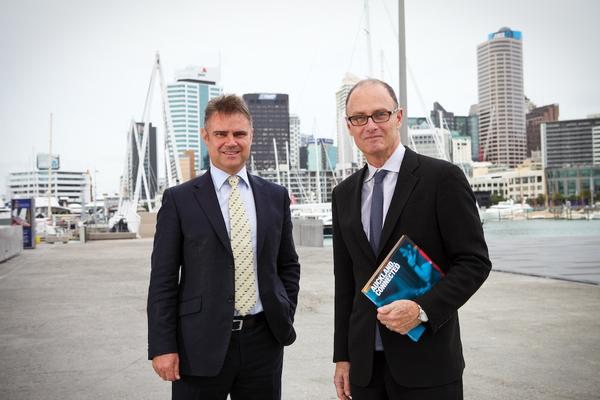AECOM Global Cities Institute launches Auckland, Connected

An integrated transport system, vibrant businesses, a third harbour crossing, and improved health and education services are what Aucklanders can look forward to by 2040 if the city gets focused, takes action and builds investor confidence according to a new study by the AECOM Global Cities Institute.
In its book titled Auckland, Connected, the Institute identifies affordability as a key challenge and recommends that Auckland Council be ruthless in its prioritisation of projects that will drive transformational change.
AECOM’s New Zealand Managing Director, Dean Kimpton, said Auckland is at cross-roads. “By 2040, it will be a very different city. Auckland is set to grow from a population of 1.5 million to an estimated 2.4 million. This substantial increase will have a major impact on transport, housing and other infrastructure.”
“The investment required to make Auckland the most liveable city is more than Council can deliver alone – Auckland needs to be public sector stimulated, but private sector-driven. The Council must inspire confidence and collaboration between the public and private sectors to attract investment and focus on critical facilities and infrastructure to ensure realistic funding,” he said.
Auckland, Connected is an in-depth response to the Auckland Plan. It is titled Auckland, Connected because it signifies that, at the heart of a transformed Auckland, is a city interconnected, with its economy, society and the physical and natural environment. The book examines how New Zealand’s largest city can address the challenges and opportunities facing its urban development around four key areas: economic growth, transportation, urban form and liveability.
“Auckland is a great city. It’s culturally diverse with a wonderful natural environment, but these attributes alone are not enough,” said AECOM Chief Innovation Officer and Head of the Global Cities Institute, Joe Brown. “By 2040, it will have made the changes necessary in its pursuit to become the world’s most liveable city, or it will have let the status quo prevail. Given the choice, we believe Aucklanders will support real change that will enable the city to realise its full potential.”
“The city cannot look at each of its urban problems in isolation. Transport for example, needs a designer’s eye. The economy benefits from a guiding social mission. Buildings are just as important as the spaces between them. A beautiful waterfront needs an economic engine to be successful,” said Mr Brown.
The AECOM Global Cities Institute worked alongside the Auckland Council, the New Zealand Institute and the University of Auckland, and lays out an interconnected blueprint for how Auckland can transform itself into a world-class city.
The book draws comparisons between Auckland and other highly ranked liveable cities (Sydney, Melbourne, Vienna, Vancouver, and Helsinki) and provides insights from international approaches and how these could be applied locally. For example, it examines transport approaches in Singapore’s Land Transport Authority Land Transport System and the CycleCity initiative in Sydney. It also draws on the Institute’s experience from working with Beijing, Jeddah and Phoenix.
Note to editor:
For more in-depth information about the contents of Auckland, Connected, please see the following sections below:
1. Key recommendations from the AECOM Global Cities Institute
2. Vision of a transformed Auckland in 2040
About AECOM
AECOM is a global provider of professional technical and management support services to a broad range of markets, including transportation, facilities, environmental, energy, water and government. With approximately 45,000 employees around the world, AECOM is a leader in all of the key markets that it serves. AECOM provides a blend of global reach, local knowledge, innovation and technical excellence in delivering solutions that create, enhance and sustain the world's built, natural and social environments. A Fortune 500 company, AECOM serves clients in approximately 125 countries and had revenue of $8.0 billion during its fiscal year 2011. The company employs more than 550 staff in New Zealand located in Auckland, Hamilton, Tauranga, Wellington and Christchurch. More information on AECOM and its services can be found at www.aecom.com.
About AECOM Global Cities Institute
AECOM’s Global Cities Institute partners with cities to diagnose their most pressing issues bringing together the best expertise in a multi-disciplinary laboratory that goes beyond traditional practice to develop solutions to urban challenges of selected cities. The Institute draws on AECOM’s fully integrated planning, design, engineering and management capabilities in New Zealand, Australia, the United Kingdom, the United States and beyond. Cities the Institute has focused on include Beijing, Jeddah and Phoenix. More information can be found at www.globalcities.aecom.com.
1. Key recommendations from the AECOM Global Cities Institute include:
Creating a high-value economy underpins Auckland’s success. The city must move to an innovation-based, high value knowledge economy. It can do this by building skill levels in higher value industries, growing high value export industries serving international markets, getting better connected to other parts of New Zealand and the world, and lifting annual productivity to match or exceed that of major trading partners.
Auckland needs to vigorously promote and retain high-value industries; leverage off iconic New Zealand brands, focusing on sectors where sustainable competitive advantages apply to a small, remote country; identify and foster high value economic activity that provides competitive advantage.
Developing policies for economic development in a carbon-constrained future and development of Auckland International Airport as an economic gateway to the world are also key.
Embracing innovation is at the heart of creating a high value economy. The Report recommends enabling better innovation by co-locating the City’s universities, Crown Research Institutes and private sectors research and development facilities, for example a ‘Grafton Research Quarter’. This will attract investment and top students.
It also recommends creating clustering and agglomerating industries (food, health, education, ICT and marine sectors) through better real and virtual connections locally and globally.
Supporting the development of high quality tertiary institutions and export education by improving co-ordination and funding across organisations is needed. The Report recommends reducing bureaucratic impediments and creating an executive board as part of the Mayor’s office to drive growth in the international education sector.
In addition, targeted investment in science and engineering will result in the establishment of start-up small to medium enterprises and future high value jobs.
Integrated transport – The price of congestion in Auckland has been estimated to exceed $1 billon per annum. While moves have been made to overcome Auckland’s poorly funded and integrated transport system, more needs to be achieved. The Report states that Auckland lacks a realistic funding model to address public transport. Road users are not paying the real cost for transport and this compounds the cycle of under investment. Realistic road pricing which could include through modern mechanisms – user charges and tolling, fuel taxes with effective collection methods, city development funding, parking/ congestion charges and levies, tax increment funding and private public partnerships – are cited as options to address this.
The land footprint devoted to Auckland roads is more than 100 times that for passenger rail and Auckland needs to put in place the City Rail Link transformational initiative, as well invest in ferry services. The use of smart technologies is needed to create efficiencies.
Inspiring confidence through credibility – The Council must be ruthless in its prioritisation of projects that will drive transformational change and leave other projects to private sector investors. For the Council, there is far greater impact, and credibility to be gained from completing a few projects well, than a mediocre response to a number of uncoordinated undertakings.
The book concludes that failure to embrace transformational change will mean Auckland will continue to lose highly skilled workers and fail to attract highly skilled migrants meaning it will lag behind more prosperous Australian and Asian cities. It will struggle to maintain quality health and education services due to wealth constraints and the city will be a gateway, not a destination, for tourists.
The AECOM Global Cities Institute was created to understand the most pressing issues facing a city or region and how to address them. The Institute draws on AECOM’s fully integrated planning, design and management capabilities to make cities and regions better.
The Institute works with cities around the world as a global think tank to diagnose their most pressing issues. It seeks to address the evolving role of cities and regions in realising social, economic and environmental aspirations. The Institute has previously partnered with Phoenix (Arizona, USA), Jeddah (Saudi Arabia) and Beijing (China).
2. Vision of a transformed Auckland in 2040:
- A population of close to 2.4 million, 18% of the population is older than 65, compared to 10% in 2010
-
GDP per capita has grown from $47,000 in 2009 to $65,000, with overall GDP doubling to almost $140 billion
-
Treaty of Waitangi issues have been resolved and the city is a highly integrated multi-cultural society
-
The loss of highly-trained workers to Australia has been reversed and skilled migrants are attracted here by the raft of opportunities and better salaries
-
Business clusters in food, health, education, ICT, marine, entertainment and several niche manufacturing sectors are well-established
-
High quality, high capacity data and information connectivity is the norm to the rest of New Zealand, and particularly Australia and Asia
-
Fast moving transport and economic connections give scale to Auckland’s markets, including the ‘golden triangle’ cities of Hamilton and Tauranga
-
A strong research and development base has been established, centred on the city’s universities, tertiary institutions and Crown Research Institutes
-
Start-up companies and established corporates are swarming to establish research and development facilities, universities are growing their research portfolios and bringing in more overseas top doctoral students
-
New Zealand and international companies are relocating to Auckland because of the depth of research available to them
-
Auckland is a leader in modern technology breakthroughs in food production, medical technology, engineering and science
-
Auckland’s contribution to the New Zealand food basket and access to relatively inexpensive energy have helped it avoid problems of short supply affecting many people in the world
-
Auckland has benefited from a planning strategy which has integrated land use and transport, reliable transport connections enable people to link easily to the heart of the city, and other residential and industrial centres within the region
-
The rail network form the backbone of an integrated public rapid transit system, buses provide feeder services that link to the rail network, to complete door-to-door transit
-
The ferry network is well developed, with fast connections around Waitemata Harbour
-
A third harbour crossing is completed
-
Commuter peaks are reduced as the result of adopting a single roading network approach, the motorway system is managed by the NZ Transport Agency and city roads managed by Auckland Transport
-
Strong environmental policies have ensured Auckland retains its unique environment and lifestyle options
-
Residents have a variety of lifestyle and housing choices, be it rural property, bungalow, townhouse, apartment, loft or downtown high rise
-
The city draws many visitors for sports, cultural, recreation and tourism events
-
Auckland benefits from the quality and availability of its preschool, primary, secondary and tertiary education facilities, and breadth of health services throughout the community.
